To create community agreements for inclusive spaces, start by involving diverse stakeholders early to gather wide perspectives and build trust. Clearly outline shared values like respect, honesty, and cultural sensitivity, using accessible language and visuals. Establish guidelines that encourage open dialogue, accountability, and ongoing feedback. Regularly review and adjust these agreements to reflect community needs. If you keep exploring, you’ll discover effective strategies to foster a respectful, inclusive, and resilient community environment.
Key Takeaways
- Engage diverse stakeholders early to incorporate broad perspectives and foster shared ownership.
- Use inclusive language, clear formatting, and visual aids to ensure accessibility for all community members.
- Establish guiding principles emphasizing respect, honesty, transparency, and cultural sensitivity.
- Regularly review and revise agreements based on community feedback to maintain relevance and trust.
- Promote accountability and consistent enforcement to cultivate a respectful, safe, and inclusive environment.
Understanding the Purpose of Community Agreements
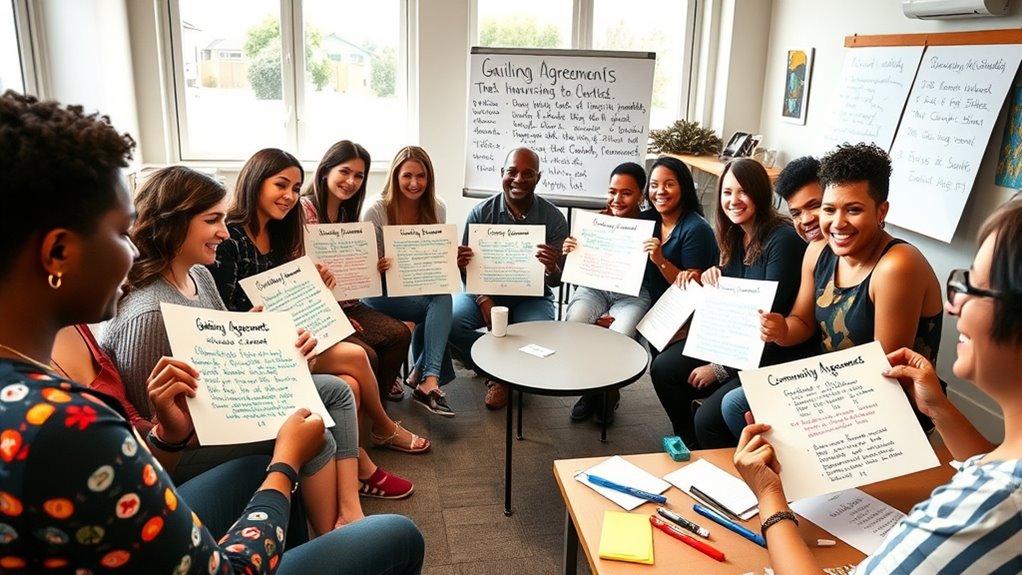
Understanding the purpose of community agreements is essential because they set clear expectations for how everyone interacts within a group. These agreements foster an environment of respect, safety, and inclusivity. When you focus on intentional listening, you show genuine interest and understanding, which helps build trust among members. Cultural sensitivity is also vital; it encourages awareness of diverse backgrounds and experiences, ensuring everyone feels valued. Community agreements guide your interactions, helping prevent misunderstandings and conflicts. They remind you to be mindful of your words and actions, promoting respectful dialogue. By establishing these shared norms, you create a space where all voices can be heard, and differences are acknowledged. Incorporating inclusive language into your interactions further enhances a welcoming environment. Developing shared ground rules can strengthen a sense of community and accountability. Recognizing diverse perspectives is crucial for fostering an environment where everyone feels respected and heard. Additionally, understanding the importance of Cultural sensitivity can significantly improve group cohesion and mutual respect. Ultimately, community agreements help you nurture a collaborative, empathetic environment where everyone can thrive.
Engaging Stakeholders in the Development Process

To create effective community agreements, you need to include a wide range of stakeholders in the process. Engaging everyone early guarantees their perspectives shape the draft and foster buy-in. Collaborating openly helps develop agreements that truly reflect the community’s needs and values. Incorporating ethical considerations ensures responsible decision-making and builds trust among participants. Additionally, understanding target demographics can help tailor the agreements to better serve diverse community members. Incorporating insights from AI ethics can further strengthen the fairness and transparency of the agreements. Recognizing the market trends related to community engagement can also inform more relevant and adaptive agreement development.
Broad Stakeholder Inclusion
Engaging a diverse range of stakeholders in the development process guarantees that everyone’s perspectives are considered and that the community agreements truly reflect the needs of all involved. To achieve this, prioritize stakeholder diversity, ensuring voices from different backgrounds, cultures, and experiences are included. Cultural sensitivity is essential; it helps you create an environment where everyone feels respected and understood. Actively seek input from marginalized groups and underrepresented communities to prevent dominance by more vocal participants. By broadening stakeholder inclusion, you foster a sense of shared ownership and trust in the process. Recognizing the importance of inclusive environments ensures that engagement is meaningful and equitable, leading to more effective and fair community agreements. Additionally, understanding how AI and automation can influence community dynamics emphasizes the need for careful stakeholder engagement to address potential ethical and privacy concerns. Incorporating equity-focused approaches can further strengthen inclusivity by addressing systemic barriers that may hinder participation. Being aware of nutritional value and how it applies to community health initiatives can help tailor engagement strategies to address diverse health needs and promote wellbeing. Remember, inclusive engagement isn’t just about numbers—it’s about meaningful participation that captures a wide array of perspectives, leading to more effective and equitable community agreements.
Collaborative Drafting Process
Building on the importance of inclusive participation, involving stakeholders directly in the drafting process guarantees their voices shape the community agreements. When you engage diverse perspectives early, you create a space for open dialogue, fostering cultural sensitivity and mutual understanding. This collaborative approach helps identify potential conflicts and work toward effective conflict resolution strategies before issues escalate. By encouraging stakeholders to contribute their insights, you ensure the agreements reflect shared values and address specific community needs. Facilitating active participation also builds trust and accountability, making it more likely that everyone will uphold the commitments. Additionally, understanding the community’s self-sufficiency needs, such as access to essential gear like water purification systems and first aid kits, ensures that the agreements are practical and supportive of resilience efforts. Recognizing the importance of breakfast delivery options can help communities explore new ways to meet members’ nutritional needs efficiently. Moreover, paying attention to storage conditions of shared resources can prevent spoilage and ensure the longevity of community supplies. Ultimately, a collaborative drafting process empowers your community to develop inclusive agreements that are fair, respectful, and adaptable to cultural differences.
Identifying Core Values and Principles
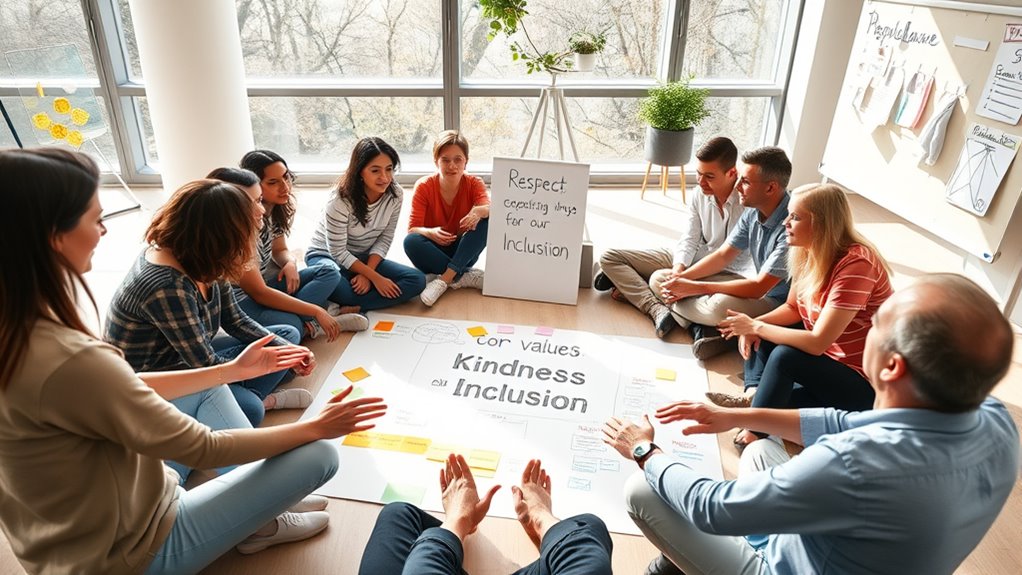
Identifying core values and principles is a crucial step in creating effective community agreements because they serve as the foundation for shared understanding and mutual respect. Your focus should be on establishing clear, guiding beliefs that reflect your community’s aspirations. This process promotes value alignment and cultural sensitivity, guaranteeing everyone feels recognized and respected. Consider these key points:
Core values build trust, respect, and inclusivity within communities.
- Clarify what matters most to your community
- Foster inclusivity through diverse perspectives
- Promote honesty and transparency
- Prioritize respect and empathy
- Ensure values support growth and accountability
- Developing Cultural Intelligence enhances the ability to understand and respect diverse values within your community. Recognizing the importance of active listening can help build empathy and deepen relationships, fostering a more inclusive environment. Incorporating diverse perspectives ensures that different experiences and backgrounds are acknowledged, which can further strengthen community bonds. Additionally, understanding cybersecurity vulnerabilities, such as those highlighted during major outages, can inform the development of resilient community agreements that adapt to digital challenges.
Co-Creating Guidelines With Community Input
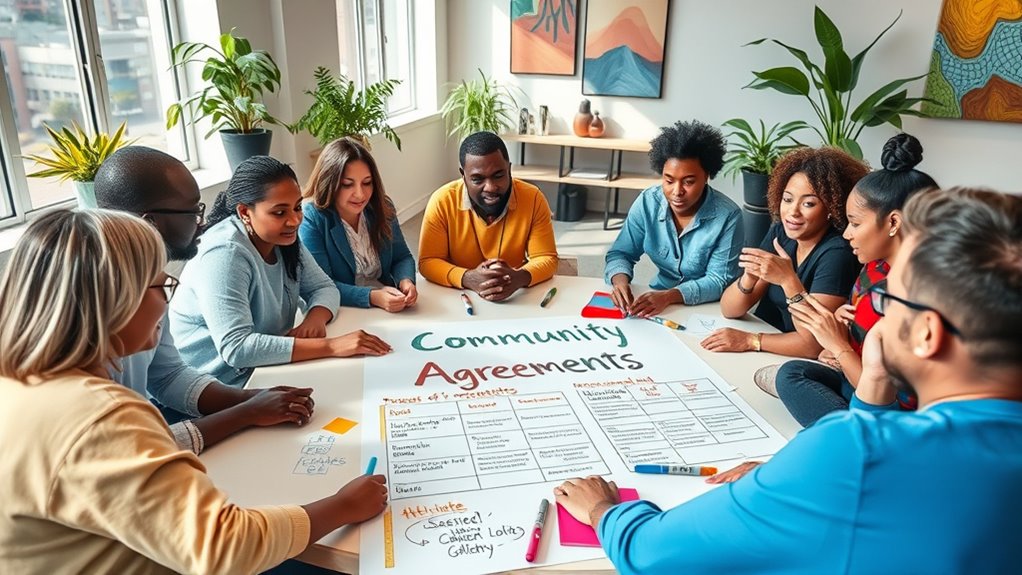
Co-creating guidelines with community input guarantees that everyone’s voices shape the rules and expectations that will govern your group. When you involve community members in this process, you ensure cultural sensitivity is prioritized, respecting diverse backgrounds and perspectives. This collaborative approach helps identify potential conflicts early, making conflict resolution more straightforward when disagreements arise. By actively listening and integrating different viewpoints, you create shared ownership of the guidelines, fostering trust and commitment. Encouraging open dialogue during this phase ensures that the rules reflect the community’s values and needs. Incorporating cookie consent preferences and other privacy considerations can further enhance trust and transparency. As a result, your community agreements become more inclusive, practical, and sustainable—setting a solid foundation for respectful, understanding interactions within your space.
Ensuring Clarity and Accessibility of Agreements
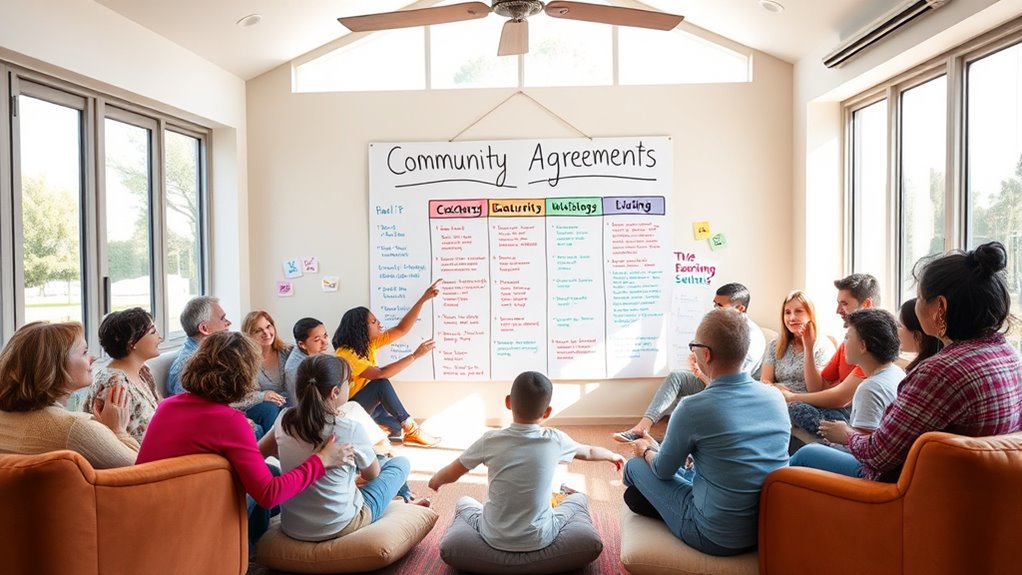
Once community guidelines are developed with input from all members, it’s important to guarantee they are clear and accessible to everyone. This involves focusing on language accessibility and visual clarity to ensure all members understand and feel respected by the agreements. To achieve this, consider:
- Using simple, inclusive language that avoids jargon
- Formatting text with clear headings and bullet points
- Choosing high-contrast colors for readability
- Providing translations or multilingual options
- Incorporating visual aids like icons or diagrams
These steps help communicate expectations effectively and make it easier for everyone to engage with the guidelines. When agreements are clear and accessible, you foster trust and ensure all voices are heard and valued within your community.
Implementing and Communicating the Agreements
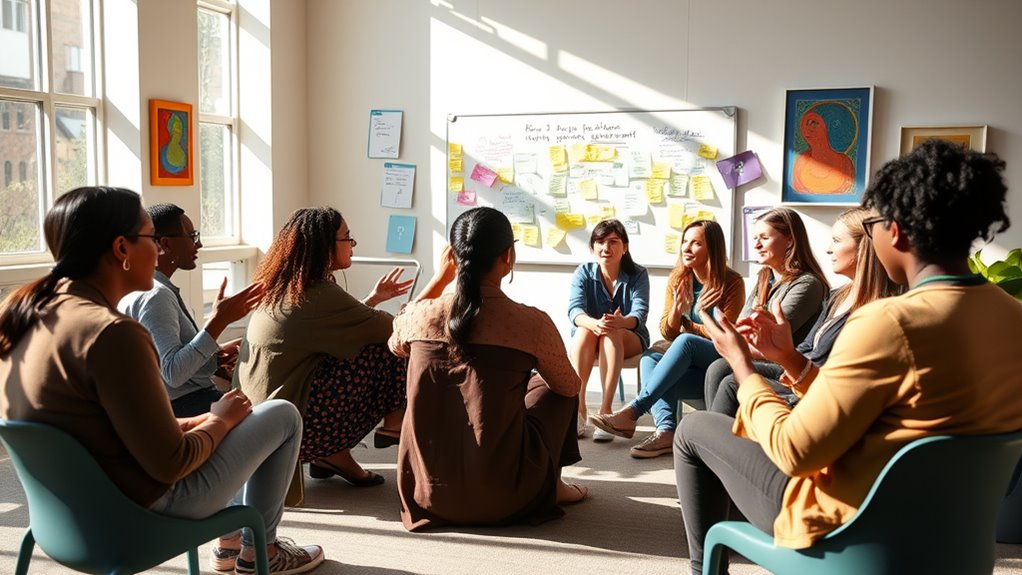
To effectively implement and communicate your community agreements, you need to actively share them with all members and guarantee they understand their responsibilities. Use clear language and accessible formats to promote cultural sensitivity, ensuring everyone feels respected and included. Regularly revisit the agreements during meetings, inviting feedback and clarifying expectations around conflict resolution. When disagreements arise, refer back to the agreed-upon principles to address issues respectfully and constructively. Emphasize the importance of listening and understanding different perspectives, fostering a safe environment for open dialogue. Consistent communication helps embed the agreements into everyday interactions, making them part of your community’s culture. By staying proactive and transparent, you build trust and reinforce your shared commitment to creating an inclusive space.
Monitoring and Revising Community Agreements
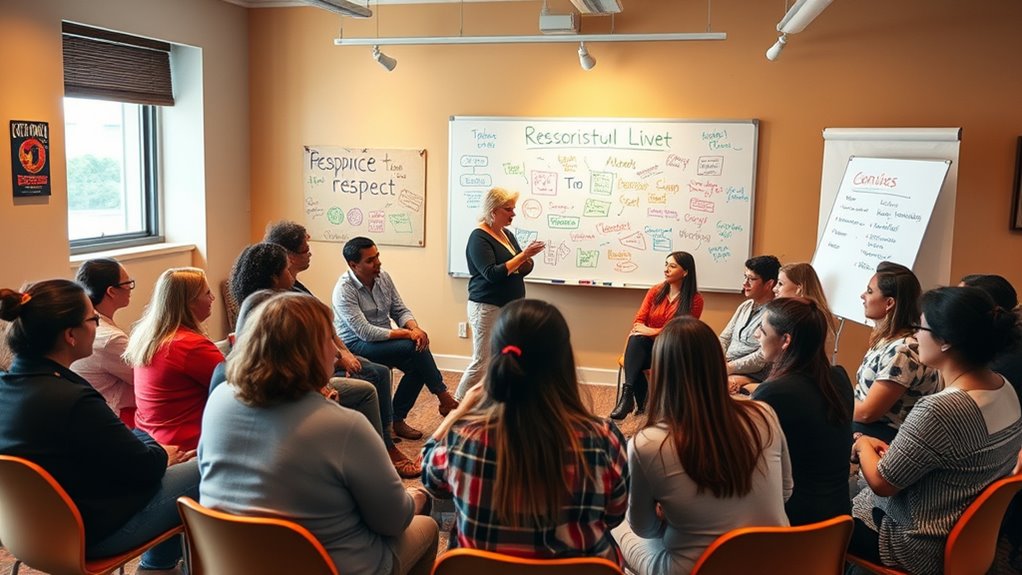
Monitoring and revising your community agreements is essential to guarantee they remain relevant and effective. Regular feedback loops allow you to identify what’s working and what needs adjustment, fostering continuous improvement. By actively seeking input from community members, you ensure the agreements reflect evolving needs and perspectives. Consider these key strategies:
- Schedule periodic reviews to assess relevance
- Encourage open discussions for honest feedback
- Use surveys to gather widespread input
- Adjust agreements based on community experiences
- Communicate changes transparently and promptly
This ongoing process helps your community stay aligned, respectful, and inclusive. It demonstrates your commitment to growth and responsiveness, ensuring the agreements support a safe environment for everyone. Continuous improvement through monitoring keeps your community agreements dynamic and meaningful.
Fostering a Culture of Respect and Accountability
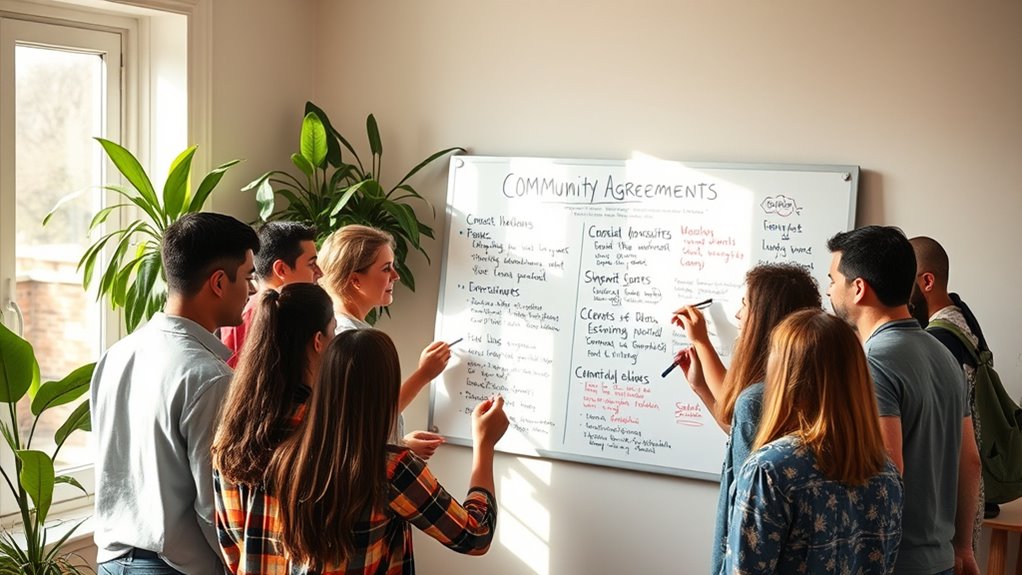
Building a culture of respect and accountability starts with clear expectations and consistent enforcement. You must recognize how power dynamics influence interactions and ensure everyone feels heard and valued. Addressing cultural sensitivity is essential; it helps create an environment where diverse perspectives are respected. When conflicts arise, hold individuals accountable in a fair and transparent way, reinforcing the community’s shared values. Encourage open dialogue, so participants feel safe to express concerns without fear of retaliation. By modeling respectful behavior and actively listening, you set the tone for others to follow. This approach fosters trust and helps build an inclusive space where everyone feels responsible for maintaining a respectful environment. Ultimately, accountability becomes a shared commitment that sustains a healthy, equitable community.
Frequently Asked Questions
How Do You Handle Disagreements Over Community Agreement Content?
When handling disagreements over community agreement content, you should use mediation techniques to facilitate open dialogue and understand different perspectives. Focus on consensus building by encouraging active listening and identifying common goals. You might ask clarifying questions or suggest compromises. Keep the conversation respectful and inclusive, ensuring everyone feels heard. This approach helps resolve conflicts constructively and creates a stronger, more unified community agreement that everyone supports.
What Tools Facilitate Effective Community Agreement Development Online?
To facilitate effective community agreement development online, you can leverage tools designed for virtual collaboration and digital facilitation. Platforms like Miro or Google Jamboard enable real-time brainstorming and visual collaboration, making it easier to gather input from diverse voices. Video conferencing tools like Zoom or Microsoft Teams support discussion and consensus-building. Using these digital tools streamlines the process, fosters inclusivity, and guarantees everyone’s voice is heard during community agreement creation.
How Often Should Community Agreements Be Reviewed or Updated?
Did you know that teams that review their agreements regularly see a 30% improvement in inclusivity? You should revisit your community agreements at least once every six months, incorporating community feedback to guarantee relevance. Periodic revisions help address evolving needs and maintain trust. By actively updating your agreements, you demonstrate your commitment to an inclusive environment, encouraging ongoing participation and fostering a respectful space where everyone feels valued.
How Can New Members Be Introduced to Existing Agreements?
When introducing new members, you should incorporate the process into your onboarding strategies. During orientation, clearly explain the existing community agreements, emphasizing their importance. Use engaging activities or discussions to help new members understand and connect with these agreements. Regularly revisit and reinforce them, ensuring everyone feels included and accountable. This approach fosters a shared commitment, making it easier for new members to integrate seamlessly into your community.
What Strategies Ensure Community Agreements Are Respected Long-Term?
Imagine a team that faces recurring conflicts due to overlooked cultural sensitivities. To guarantee community agreements are respected long-term, you should implement proactive communication strategies, like regular check-ins and feedback sessions. This encourages accountability and reinforces shared values. By fostering open dialogue and addressing issues early, you create an environment where everyone feels valued and understands the importance of respecting agreements, making inclusivity a lasting commitment.
Conclusion
Creating community agreements is essential for fostering inclusive, respectful spaces. Did you know that communities with clear guidelines see a 30% increase in participation and trust? By actively involving everyone in shaping these agreements, you build a culture where respect and accountability thrive. Keep communication open, monitor progress, and revise as needed. Together, you can create a welcoming environment where all voices are valued and heard.









